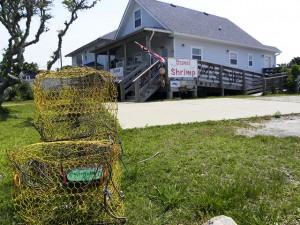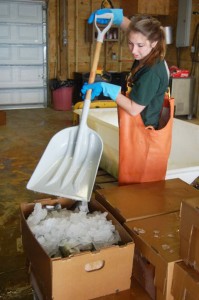By ART LATHAM
It’s showtime at Avon Seafood on Hatteras Island, Where the “Fin Twins” — Alexis Gray and Carolina Austin — are hard at work on the same daily jobs their friends and relatives have done for generations along North Carolina’s coast.
The difference: These chores are performed for the cameras.
The “twins,” sporting neon orange bib coveralls, are Cape Hatteras Secondary School of Coastal Studies students, working with their classmates on their Hatteras Connection Seafood Marketing Youth Team project.
Islander Susan West, an author, journalist and blogger, coordinates Hatteras Connection, a pioneering community-based, sustainable economic development and environmental stewardship project that includes the youth team’s efforts.

Crab pots in Hatteras Village. Photo by Art Latham.
“They’re explaining how buying locally harvested seafood helps sustain the culture and the economy of Hatteras Island and what the commercial fishing industry means to the community,” West says.
West and Sara Mirabilio, North Carolina Sea Grant fisheries specialist, provide the teens with information and resources on commercial fishing and seafood marketing. Linda Austin, CHSS media coordinator, handles middle- and high-school website design and blog creation matters, as well as the video camera. Tracy Shisler, CHSS science teacher, also advises the group.
Today’s dockside video production is part of a multifaceted social media project bootstrapped by a North Carolina Sea Grant minigrant to help Hatteras youth tell their story of traditional island life.
The high schoolers are using Facebook, photos, videos and more.
Middle-school students however, opted for a wiki, a collaborative Web page and glog — for “graphical blog” — to make interactive posters.
“Once the students develop a website, they can expand and innovate forever, if there is interest,” West says.
Judging from a recent project update meeting, the middle schoolers seem very interested.
“My dad is a geek big-time, and he begged me to take a computer course in summer camp before this project. I did, and when I saw Glogster, I said, ‘Wow! I can add this to the wiki,'” Libby Tawes says.
Delaney Johnson, who says she casts a net on the soundside daily, thinks being familiar with local seafood helps her make better seafood choices in restaurants.
With relatives working in an island restaurant known for featuring fresh local fish on its menu, Aron Stowe says he immediately knew he wanted to be on the team.
And Chris Clark says he got involved because “I live 100 feet from the ocean. Every day I’d see the fishing boats come up and fish, and that was exciting.”
Whatever the students’ approach, all projects are aimed ultimately at “helping seafood branding efforts stay strategically connected to current and future consumers right where they hang out: online,” West explains.
“Fishing is a part of the island’s culture and heritage, and it should be part of our future, too,” she adds.
PULLING TOGETHER
That’s an important point because coastal North Carolina’s scattered, unincorporated traditional fishing villages — including a group stretching from Hatteras Island in Dare County to the North River in Carteret County — are feeling the pressures of increasing population and market competition and fisheries regulations.
But like a purse seine’s webbing, the region’s residents pull together to help concentrate each other’s community development efforts.
For instance, a local branding and education program — Carteret Catch — initiated with leadership from Barry Nash, North Carolina Sea Grant seafood marketing specialist, spawned programs in other fishing communities: Brunswick Catch, Outer Banks Catch and Ocracoke Fresh.
Hatteras Connection’s project will provide online materials for Outer Banks Catch, and be available for Sea Grant, the N.C. Department of Agriculture and Consumer Services and others for promotional programs, West says.
And North Carolina Sea Grant-funded social science research by Lisa Campbell and others at Duke University Marine Laboratory and an accompanying documentary in 2008-09 were a springboard for the more recent formation of Saltwater Connections. This regional project serves villages along the Outer Banks National Scenic Byway.
For example, Saltwater Connections, with Hatteras Connection cooperating, initiated the Hatteras Island Asset Mapping project to assist interested residents and visitors identify significant cultural natural and business assets — called local treasures. Similar mapping is being done on Ocracoke and in Down East Carteret County, West explains.
LEARNING VALUABLE SKILLS
Commercial fishing is neither easy work, nor for the fainthearted.

Carolina Austin shovels ice to chill outgoing voice. Photo courtesy Hatteras Connection.
That’s evident as you watch the intrepid Fins duo unpack iced fish coolers from a docked boat, haul baskets full offish to a weighing station, unpack and weigh fish, wash down fish residue, dump weighed fish into a sturdy box for transport and shovel ice in behind them. Then they do it again.
“Keep the boats clean and your tackle right or you’re history,” CHSS student Cameron Whitaker says.
He should know. When he’s not in school, Whitaker works on large boats — called head boats — serving visiting anglers. He also commercially fishes and works winter evenings at one of Hatteras Village’s fish houses.
The social media project also is an experiment in cooperating with full-time watermen, Mirabilio says.
“Whenever outside TV crews come here, they’re time restricted and frequently weather constrained, and don’t get on-water shots,” she explains. “We’re hoping to get some action shots by the people who fish, and what better way to show fishing than through their children on the water helping them do it? This also helps the students have a vested interest in their communities.”
The skills the students are learning will be valuable down the line.
“They’re on the path to developing some great marketing tools,” Mirabilio adds.
Jack Thigpen, North Carolina Sea Grant extension director, agrees.
“This project is at the core of what Hatteras Connection is all about: Linking fishing families with the community as a whole,” he says. “Fishing is an integral part of the history, culture, economy and future in Hatteras and many other small towns on our coast.”
West, whose husband, Rob, fishes commercially, understands the watermen’s situation well. “Hatteras Connection isn’t blind to the very real regulatory and trade issues battering our island’s fishing fleet,” she says.
“We have decided against allowing those challenges to rob us of the resourcefulness that has always served our community,” West says. “We’re committed to working to ensure a future for new generations of watermen on Hatteras Island.”
For more information, go to:
• www.facebook.com and search for “Hatteras Connection Seafood Marketing Team”
• www.outerbankscatch.com
This article was published in the Autumn 2011 issue of Coastwatch.
For contact information and reprint requests, visit ncseagrant.ncsu.edu/coastwatch/contact/.
